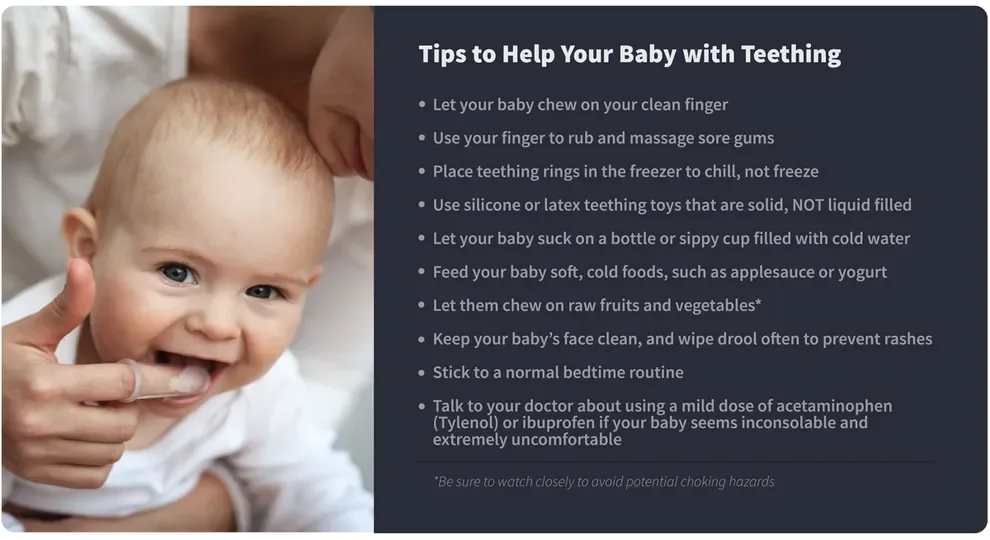What Is Teething? Causes, Symptoms & Soothing Techniques

Table of Contents
- What Is Teething?
- Signs & Symptoms of Teething
- How Long Will It Last?
- Soothing Techniques
- Things to Avoid
Babies are born with their teeth under the gumline, and teething is when they start to pop through. It can be extremely uncomfortable for the baby and difficult for parents to manage as well. Teething can make a baby fussy, cranky, and have trouble sleeping.
Luckily, teething is relatively short-lived and there are several ways that you can help soothe an irritable and teething child including cold washcloths and special teething toys.
What Is Teething?
Babies are born with all 20 baby teeth; however, these teeth are not yet through the gumline. Teething is when these baby teeth break through the gums, or erupt.1
Babies can start teething as early as 6 months old or not until a year or so. Parents can usually tell when teething begins as sleep patterns and behavior change.
Signs & Symptoms of Teething
Babies usually start putting most things into their mouths and have increased saliva around 3 months old. These can be symptoms of teething, but this does not necessarily mean that a tooth is imminent. This is a normal phase of development.
Teeth do not usually start coming in until at least six months old. Once teething does start, you will usually know based on the changes in your baby’s attitude.
Signs of teething include the following:2
Irritability
Sleep difficulties
Increased drooling
Loss of appetite
Fussiness
Red, sore, and swollen gums
Putting things in their mouth more than normal
When a tooth is actively erupting through the gums, it can cause a minor increase in temperature, but nothing above 100.4 degrees is normal for teething.
Teething does not cause diarrhea, high fever, rash, or cold symptoms. If your baby has any of these along with teething symptoms, be sure to check with your pediatrician.
How Long Will It Last?
Typically, a child will start teething between 6 and 8 months old. They will generally have all 20 baby teeth by the time they are 30 months old.3
Usually, the bottom two front teeth come in first; then, the top two front teeth follow. The molars are often next, and then, the eye teeth or canines follow those.
Most children will have all 20 of their baby teeth by their 3rd birthday at the very latest. Teeth often emerge in groups, and a baby may get several teeth in succession.
Teething is a temporary event in the grand scheme of things. But there are several things you can do to ease your baby’s (and your) discomfort during this time.
As soon as your baby’s first tooth comes in, be sure to start brushing it. Make an appointment to see your dentist for your baby’s first visit.
Soothing Techniques

Teething babies will often want to chew on virtually anything in an effort to soothe their tender and inflamed gums. If they do not have any visible teeth yet, you can let them chew on your clean finger. It can be especially soothing if you dip it in cold water first. Then, use the finger to rub and massage the sore gums.
Teething toys, such as teething rings, can often be placed in the freezer to chill (but not to freeze solid), and they will feel good for teething babies. Stay away from liquid-filled teething toys, as they can potentially become filled with bacteria or rupture. Instead, opt for silicone or latex toys that are solid.
A wet, clean washcloth can also be refrigerated and used to soothe irritated gums. Just be sure to wash the washcloth before refrigerating it and using it again.
Here are some additional tips:
Let your baby suck on a bottle or sippy cup filled with cold water. The one you use will depend on the age of your baby.
Babies who are eating solids can enjoy soft, cold foods, such as applesauce or yogurt.
Older babies who are eating more solids may enjoy chewing on raw fruits and vegetables. Be sure to watch closely to avoid potential choking hazards.
Keep your baby’s face clean, and wipe drool often to prevent rashes.
Stick to a normal bedtime routine, if possible, to prevent future sleep issues.
Talk to your doctor about using a mild dose of acetaminophen (Tylenol) or ibuprofen if your baby seems inconsolable and extremely uncomfortable.
Things to Avoid
Be careful with teething products and toys that can become choking hazards for babies. Solid materials are better. Do not tie teething rings around a baby’s neck, as this can also become a choking hazard.
Teething tablets and numbing gels are not considered safe until your baby is at least 2 years old. Often, they are not very helpful anyway, as extra saliva is likely to wash them away too fast to be beneficial for long.
The U.S. Food and Drug Administration (FDA) warns against homeopathic teething remedies, as many of these products contain harmful toxins.
